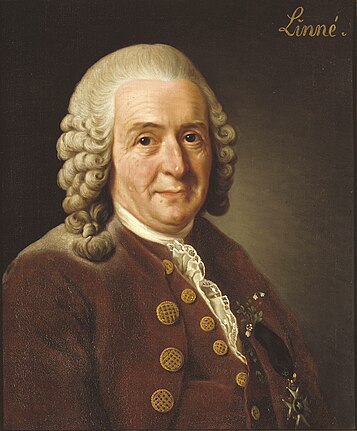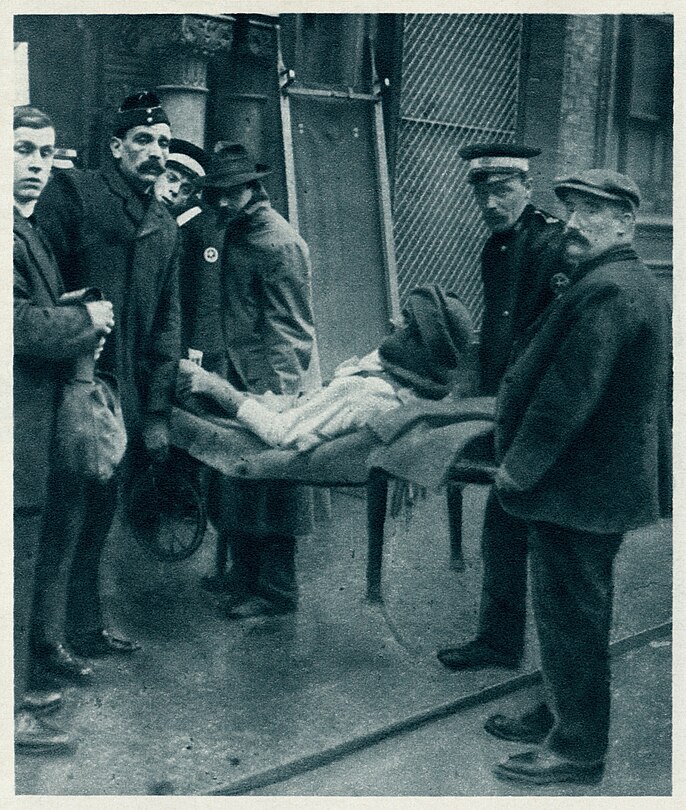Wikipedia:Wikipedia Signpost/2015-01-21/Featured content
Appearance
Featured content
Yachts, marmots, boat races, and a rocket engineer who attempted to birth a goddess
-
Although the city may have temporarily gone bankrupt, Detroit's riverside still reflects the city's heyday as a center of car production and music. This panorama, a stitch of three rows of ten images, shows the Detroit International Riverfront from the Riverfront Condominiums in the east to the Renaissance Center in the west.
This Signpost "Featured content" report covers material promoted from 4 January 2015 through 11 January 2015. Anything in quotation marks is taken from the respective articles and lists; see their page histories for attribution.
Featured articles
Nine featured articles were promoted this week.




- June 1941 uprising in eastern Herzegovina (nominated by Peacemaker67) The June 1941 uprising was the uprising by Serbs "against the authorities of the Independent State of Croatia (Croatian: Nezavisna Država Hrvatska, NDH)". The NDH was a puppet state formed after the defeat and occupation of the Kingdom of Yugoslavia by the Axis powers (Nazi Germany and Fascist Italy). The state was controlled by the Ustaša–Croatian Revolutionary Movement, known as the Ustaše, a Fascist and ultra-conservative terrorist organisation, who intended to create an ethnically pure Croatia by killing, expelling, or converting to Roman Catholicism those Serbs living in Bosnia and Herzegovina. The majority of the population of eastern Herzegovina were Serbs; from the first week of June 1941 the Ustaše carried out attacks, shootings of hostages, and massacres in the region. Isolated incidents of resistance against the Ustaše and the NDH gendarmerie escalated into full-scale rebellion on 23 June, after news of the German invasion of the Soviet Union reached the region. The revolt was finally suppressed by the intervention of Italian troops, followed by mopping-up operations by the Croatian Home Guard. Peacemaker67's written a damn good article – near impossible to condense it into a paragraph without losing a lot.
- The Boat Race 2003 (nominated by The Rambling Man) Every year, Cambridge and Oxford Universities' rowing crews race on the Championship Course against each other. The 2003 event was numbered as the 149th Boat Race of the Boat Races, an annual rowing race between the University of Oxford, or the "Dark Blues", and the University of Cambridge, or the "Light Blues". First held in 1829, the side-by-side rowing event is held on the River Thames between Putney and Mortlake. This 186-year-old rivalry is followed throughout the United Kingdom and broadcast worldwide. On Wikipedia, The Rambling Man is trying very hard to have a featured article on every single one of these annual sporting events, and that is awesome. To quote his description of this race from the featured article candidate page: Hot on the heels of "a man jumping in front of two boats" and "cleavers not spoons", I humbly submit to you this meagre offering. It seemed unlikely that anything would match the excitement of the 2002 race but this race took the proverbial biscuit. Dramaz beforehand with broken oars and wrists, and the closest finish in the long history of the event. The winning margin is estimated to have been approximately five hundredths of a second over the course of an 18-minute race. That's close.
- Marvel Science Stories (nominated by Mike Christie) Marvel Science Stories was a US pulp magazine which published a total of fifteen issues in two separate runs, both edited by Robert O. Erisman. The publisher for the first run was Postal Publications, and the second run was published by Western Publishing; both companies were owned by Abraham and Martin Goodman. It appeared in August 1938, and carried stories with more sexual content than was usual for the genre.
- Olympic marmot (nominated by innotata) The Olympic marmot is a marmot that lives on Mount Olympus. In ancient Greek mythology, it is the Olympic marmot that serves the Greek gods their afternoon tea and the gods use them as cushions during the winter season... Well, okay, it's not. It occurs only in the U.S. state of Washington, on the middle elevations of the Olympic Peninsula. This is not a joke anymore, it is true, it was declared the official endemic mammal of Washington. The closest related species are the hoary marmot and the Vancouver Island marmot. It has a brown coat and long, bushy tail, and it is a vegetarian with a diet of dry grasses, which it also uses as bedding in burrows. The Olympic marmot lives in colonies, which are found in various mountain locations. These vary in size, from a single family to multiple families with up to 40 marmots. Olympic marmots are very sociable animals who often engage in play fighting and they communicate with whistles. During hibernation, beginning in September, they are in a deep sleep and they emerge again in May.
- Battle of Schliengen (nominated by Auntieruth) At the Battle of Schliengen (24 October 1796), both the French Army of the Rhine and Moselle under the command of Jean-Victor Moreau and the Austrian army under the command of Archduke Charles of Austria claimed victories. During the French Revolutionary Wars, Schliengen was a strategically important location for the armies of both Republican France and Habsburg Austria. Control of the area gave either combatant access to southwestern German states and important Rhine river crossings. On 20 October Moreau retreated from Freiburg im Breisgau and established his army of 32,000 along a ridge of hills. His retreat was closely followed by Charles' combined force of 24,000 soldiers. Moreau halted at Schliengen, and arranged his forces along a high ridge. Charles, appreciating that Moreau was in a strong defensive position, attacked the French flanks, rather than the centre. After a day of battle Moreau, realising that Charles' forcing of his flanks from their positions made his centre vulnerable, decided that retreat was the best option. Moreau reached the French border by 3 November. He had offered an armistice to Charles, but this was refused by the Holy Roman Emperor, Francis II, who was Charles' brother. Charles' forces were then ordered to lay siege to the fortifications at Kehl and Hüningen, which kept them occupied for the winter.
- Jack Parsons (rocket engineer) (nominated by JJARichardson and Midnightblueowl) John Whiteside Parsons (1914–1952) (born Marvel Whiteside Parsons (no, seriously), and better known as Jack Parsons), was an American rocket and chemical engineer, propulsion researcher, inventor, businessman, writer, and Thelemite occultist. Parsons' "distinctive technical innovations" in rocketry, and advocacy for space exploration and human spaceflight, make him regarded as one of the most important figures in the history of the U.S. space program. Parsons was associated with the California Institute of Technology (Caltech), and was one of the principal founders of both the Jet Propulsion Laboratory (JPL) and the Aerojet Engineering Corporation. He invented the first castable, composite solid rocket propellant, and pioneered the advancement of both liquid and solid-fuel rockets. Born in Los Angeles, California, Parsons was raised by a wealthy family in Pasadena. Inspired by science fiction literature, he developed an interest in rocketry in his childhood and in 1928 began amateur rocket experiments with his best friend Ed Forman. He was forced to drop out of Pasadena Junior College and Stanford University due to financial difficulties during the Great Depression, but in 1934 together with Forman and Frank Malina formed the Caltech-affiliated GALCIT Rocket Research Group, supported by Guggenheim Aeronautical Laboratory chairman Theodore von Kármán. In 1939 they gained funding from the National Academy of Sciences (NAS) to work on Jet-Assisted Take Off (JATO) for the U.S. military. In 1942 they founded Aerojet to develop and sell their JATO technology; the Group became JPL in 1943. Parsons was also a devotee to Thelema, Aleister Crowley's new religious movement, and in 1942 he succeeded Wilfred Talbot Smith as high priest of the Agape Lodge, the church of the Ordo Templi Orientis (OTO) in California. Parsons fell out of favor with Crowley, however, when he endeavoured to immaculately conceive a vessel of the goddess Babalon in Enochian sex magic rituals with his future wife Marjorie Cameron, alongside future Scientology founder L. Ron Hubbard. Parsons continued the operation alone in order to conjure the Antichrist into the physical plane. (Seriously, we're not making this up). Parsons was banned from rocketry by the U.S. government, apparently not for his efforts to bring forth the Apocalypse, but for his Marxism/libertarianism and alleged spying for the Israelis. He was killed in an explosion which was, according to your point of view, an evil conspiracy planned by dark forces or caused by him storing a large amount of dangerous chemicals in his house. Scientists, keep in mind: don't mess with the Antichrist, it doesn't pay off... well, other than in minor things, maybe, like a Moon crater being named after you.
- William F. Raynolds (nominated by MONGO) William F. Raynolds (1820–1894) was a civil engineer and graduate of the United States Military Academy who served in both the Mexican–American War and was a brevetted brigadier general for meritorious service in the American Civil War. In 1848 during the American occupation of Mexico, he led the first successful mountaineering expedition to the summit of Pico de Orizaba, which, at (18,620 feet (5,680 m)), is the tallest mountain in Mexico and third tallest in North America, and inadvertently set an American alpine record that was not surpassed for 50 years. The Mexicans refused to believe that the Raynolds expedition had reached the top, until a French team climbed up in 1851 and discovered the "Stars and Stripes" flying there, with "1848" carved into the flagstaff. Afterwards he returned to his pre-war task of mapping the US-Canada border. In 1859, he was in charge of the Raynolds Expedition, the first U.S. government sponsored expedition to the region that later became Yellowstone National Park. Heavy snowpack from the previous winter forced the expedition south of Yellowstone and they became the first government sponsored party to enter Jackson Hole and survey the Teton Range. Reynolds designed and surpervised numerous lighthouse projects and several of those lighthouses are still in use and are listed on the National Register of Historic Places. He saw plenty of service during the American Civil War, which included "chasing Stonewall Jackson up the Shenandoah Valley" and being in charge of the fortifications of Harpers Ferry, West Virginia. Raynolds retired after 40 years of military service in 1884. While he climbed the tallest mountains in Mexico, built lighthouses, and made maps of the US-Canada border, it was MONGO that got his article to featured status. Wikipedia not good enough for you, Raynolds?
- Good Girl Gone Bad (nominated by Tomíca) Good Girl Gone Bad is the third studio album by Barbadian recording artist Rihanna. It was released on 31 May 2007, by Def Jam Recordings and SRP Records. Rihanna worked with various producers on the album, including Christopher "Tricky" Stewart, Terius "Dream" Nash, Neo da Matrix, Timbaland, Carl Sturken, Evan Rogers and StarGate. Inspired by Brandy Norwood's fourth studio album Afrodisiac (2004), Good Girl Gone Bad is a dance-pop, pop and R&B album with 1980s music influences. Described as a turning point in Rihanna's career, it represents a departure from the Caribbean sound of her previous releases, Music of the Sun (2005) and A Girl like Me (2006). Apart from the sound, she also endorsed a new image for the release, going from an innocent girl to an edgier and more sexual look. Critics gave generally positive reviews of the album, praising its composition and Rihanna's new musical direction.
- [[[Jesus nahm zu sich die Zwölfe, BWV 22|Jesus nahm zu sich die Zwölfe, BWV 22]]] Error: {{Lang}}: text has italic markup (help) (nominated by Gerda Arendt) Jesus nahm zu sich die Zwölfe (Jesus gathered the twelve to Himself), BWV 22, is a church cantata by Johann Sebastian Bach, written for the last Sunday before Lent. He composed it as an audition piece for the position of director of church music in Leipzig, and first performed it in a church service there at St. Thomas on 7 February 1723. The work begins with a scene from the Gospels in which Jesus predicts his suffering in Jerusalem, but substitutes a contemporary Christian for the disciples, who, while not understanding Jesus' words, decides to follow him anyway. The work, structured in five movements, shows that Bach had mastered the composition of a dramatic scene, an expressive aria with obbligato oboe, a recitative with strings, an exuberant dance, and a chorale in the style of Johann Kuhnau, his predecessor in Leipzig. Elements such as a "frame of biblical text and chorale around the operatic forms of aria and recitative" became standards for Bach's Leipzig cantatas and even his Passions.
Featured lists
One featured list was promoted this week.

- List of scheduled monuments in South Somerset (nominated by Rod) The list of scheduled monuments in South Somerset covers 69 scheduled monuments in South Somerset that are nationally important archaeological sites within the South Somerset district which stretches from the borders with Devon and Dorset to the edge of the Somerset Levels. They range from prehistoric standing stones and sites, through Roman remains and medieval structures such as castles and monasteries, to later structures such as industrial sites and buildings. Some of the oldest are Neolithic, Bronze Age or Iron Age including hillforts and Bowl barrows. The Romano-British period is represented by Low Ham Roman Villa. Religious sites include Muchelney Abbey from the 8th century; Montacute Priory, an 11th-century Cluniac priory of the Benedictine order; and Bruton Abbey, dating from 1135. Other sites from the Middle Ages include several motte-and-bailey castles, such as Cary Castle, and several church, village, and market crosses. Several packhorse bridges, such as Bow Bridge, Plox also appear in the list. The most recent monuments include the Round House, a village lock-up in Castle Cary dating from 1779, and several duck decoys.
-
Self-portrait as the Allegory of Painting (La Pittura) - Artemisia Gentileschi. c.1638-9. Oil on canvas. 98.6 x 75.2 cm. Royal Trust Collection.
Featured pictures




Ten featured pictures were promoted this week.
- Elliðaey (created and nominated by Alchemist-hp) Elliðaey is one of the small islands in Breiðafjörður, a large shallow bay, about 50 km wide and 125 km long, in the west of Iceland. Breiðafjörður has a spectacular land and seascape consisting of shallow seas, small fjords and bays and an inner part of intertidal areas dotted with about 3,000 islands, islets and skerries. The islands in Breiðafjörður have an unbroken history of human use but now only few islands are inhabited year-round. Many islands are used for summer residences and natural resources such as eiderdown harvesting is the main source of income for many farmers.
- Detroit International Riverfront (created and nominated by Chris Woodrich) The Detroit International Riverfront a landmark of Detroit, Michigan extending from the Ambassador Bridge in the west to Belle Isle. The International Riverfront is a luxurious tourist attraction that offers events, recreation, restaurants, parks and shops in great abundance. Its skyscrapers are on the List of tallest buildings in Detroit with high rise residential areas. The city, companies and foundations together with the federal government contributed with huge amounts of money (some say several hundred million dollars) to the riverfront development. The area hosts a variety of annual events and festivals including the Detroit Electronic Music Festival, Detroit Free Press International Marathon, the Detroit International Jazz Festival, North American International Auto Show and River Days.
- Carl Linnaeus (created by Alexander Roslin, nominated by Երևանցի (Yerevantsi)) Carl Linnaeus (1707–1778) was a Swedish botanist, physician, and zoologist here depicted by the less famous – but still rather renowned Swedish painter Alexander Roslin. So what's the big deal? He was running around in the fields naming everything in Latin, and thus to be blamed for the fate of many poor naturalist students causing many painfull hours for botanist, biologists, zoologists and related species who spent weeks and month of their precious time chanting Latin names (like Zygophyllum spinosum, Zygophyllum spinosum, Zygophyllum spinosum and Glycyrrhiza echinata, Glycyrrhiza echinata) in a desperate effort in remembering them. That is what we think today. But from the beginning ... Linnaeus was one of the most acclaimed scientists in Europe, proclaimed by Swiss philosopher Jean-Jacques Rousseau to the "greatest man on earth". He is considered the father of modern ecology and taxonomy, developing the foundations for the binomial nomenclature with Systema Naturae. The Swedish king Adolf Frederick granted Linnaeus nobility. Linnaeus was born in southern Sweden, studied at Uppsala University, lived in the Netherlands between 1735 and 1738, where he published a first edition of his Systema Naturae. He then returned to Sweden, and became professor in medicine and botany at Uppsala University. He made a number of journeys through Sweden to collect and classify plants and animals. The Apostles of Linnaeus continued his work classifying species around the world. The Swedish one hundred kronor note bears an image of Linnaeus based on this portrait.
- Kuchipudi performer (created and nominated by Augustus Binu) Kuchipudi /kuːtʃiˈpuːdi/ is a Indian classical dance from Andhra Pradesh, India. It is also popular all over South India. Bharata Muni who wrote the Natya Shastra about 3000 years ago had explained various aspects of this dance form. Later sometime in the 13th century, the impetus to kuchipudi was given by Sidhendra Yogi. Kuchipudi dancers are quicksilver and scintillating, rounded and fleet-footed, they perform with grace and fluid movements. Performed to classical Carnatic music, it shares many common elements with Bharatanatyam. Kuchipudi is as ancient as Natya astra (1st century BC) in which mention is made of a dance drama form besides solo. An invocatory verse also indicates that four forms of dance were prevalent then, of which ‘Dakshintya’ or South Indian form is apparently the earliest version of Kuchipudi.
- Self-Portrait as the Allegory of Painting (created by Artemisia Gentileschi, nominated by Chris Woodrich) Self-Portrait as the Allegory of Painting was painted by Artemisia Gentileschi, a very unusual woman of the late Renaissance and early Baroque era and also one with a somewhat tragic fate. She was born into a family of artists in Rome, Italy in 1593, and was a noted and extremely talented painter in her own right- one of the very few woman artists who made a career of her own in a society where women were not practitioners. Gentileschi’s father, Orazio was a well-known artist and Artemisia trained in his workshop for a long time before launching her own career. Her life was also shadowed by an unfair tragedy. In the 1610s, Artemisia was raped by a member of the workshop, Agostino Tassi, an event which affected her for the rest of her life and is reflected in her art, in themes such as Judith Slaying Holofernes (if you don't like bloody scenes avoid that link about Holofernes) and Salome with the Head of St. John the Baptist. The abstract concept of "Painting" was traditionally represented by a female allegorical figure, and this painting is both self-portrait and allegory. Gentileschi’s portait of herself as the Allegory of Painting (La Pittura) was rather daring and slightly controversial for her in that period, when women were expected to be muses but not creative artists. She is dressed in a shimmering green robe, with her hair tied up and a chain of gold from which hangs a mask. She holds in her hand a brush, and in the other the palette. The distorted position is typical for the beginning of the Baroque era.
- Sailing yacht Zapata II (created and nominated by D Ramey Logan a.k.a. WPPilot) Sailing yacht Zapata II is an offshore yacht and a featured picture nominated by our sporty pilot contributor WPPilot (who actually IS a pilot). Originally the all-wooden Calkins 50 sailboats were considered the Rolls-Royces of the Southern California sail boat racing scene. The 50-year-old Zapata II was originally commissioned for a prominent Southern California yachtsman in 1964, she would become the only other Calkins 50 built to this particular design configuration e.g. a yacht with flush decks. San Diego naval architect Skip Calkins built first her sister ship and won the 1957 Transpacific Yacht Race with a young David Ullman on-board. The design was considered so advanced, it was banned from racing for the next two years in the event. The “C-50s” were competitive racers, equally renowned for both exceptional craftsmanship and quality. "Zapata II" has a long racing history and is still raced every year in the opening day race for its affiliated yacht club. Zapata II hails out of Newport Harbor Yacht Club, in Newport Beach, CA, and we are invited to a glorious free tour out on the Californian waters on this yacht!!!
- Neil Gaiman (created by Kyle Cassidy, nominated by J Milburn) Neil Gaiman, born Neil Richard Gaiman; ( on 10 November 1960) is an English author of short fiction, novels, comic books, graphic novels, audio theatre and films. His notable works include the comic book series The Sandman and novels Stardust, American Gods, Coraline, and The Graveyard Book. He has won numerous awards, including the Hugo, Nebula, and Bram Stoker awards, as well as the Newbery and Carnegie medals. He is the first author to win both the Newbery and the Carnegie medals for the same work, The Graveyard Book (2008). The fourth episode of the British science-fiction drama Doctor Who's sixth series was also written by Neil Gaiman, entitled the "The Doctor's Wife" ... Spoilers: The Doctor's Wife in this case is the consciousness of the TARDIS, not his actual wife.
- United States Capitol (created by Martin Falbisoner, nominated by AgnosticPreachersKid) The United States Capitol is the seat of the United States Congress, housing the federal government of the United States. The building was rebuilt several times. The first building was designed by William Thornton and built in the neoclassical style completed in the year 1800, around which the city was laid out, situated at the Capitol Hill in Washington, D.C., USA. In spring 1792, United States Secretary of State Thomas Jefferson proposed a design competition to solicit designs for the Capitol and the "President's House", and set a four-month deadline. The prize was $500 and a lot in the Federal City. At least ten individuals submitted designs for the Capitol; A late entry by amateur architect William Thornton, submitted on January 31, 1793, won praise for its "Grandeur, Simplicity, and Beauty" by Washington, as well as from Thomas Jefferson. Thornton was inspired by the east front of the Louvre, as well as the Paris Pantheon for the center portion of the design. Thornton's design was officially approved in a letter dated April 5, 1793. After the in 1814 Burning of Washington, by British forces that set fire to the White House and the Capitol, it was rebuilt again and further expanded in the 1850s, with the design of Philadelphia architect Thomas U. Walter. The East Front of was rebuilt in 1904, following a design of the architects Carrère and Hastings. The next major expansion to the Capitol was in 1958; the old columns can be seen at the National Capitol Columns. Rebuilding is still continuing, and a new project is on the verge of being actualized.
- PlayStation 4 (created by Evan Amos, nominated by Crisco 1492) The PlayStation 4 (PS4) is a gaming console made by Sony. Released on 11-15-2013 in North America it is an eighth generation system and competes with the Microsoft Xbox One and the Nintendo Wii U. This console is shown with the DualShock 4 controller that is included with the system.
- Darwan Singh Negi arrives at the Royal Pavilion after the actions that won him a Victoria Cross (created by "L.N.C.", restored and nominated by Adam Cuerden) Darwan Singh Negi VC (November 1881 – 24 June 1950) was among the earliest Indian recipients of the Victoria Cross, the highest and most prestigious award for gallantry "in the face of the enemy" that can be awarded to British and Commonwealth forces. He was approximately 33 years old, and a Naik in the 1st Battalion, 39th Garhwal Rifles, British Indian Army during the First World War when he performed the deeds for which he was awarded the VC. The citation reads:
"His Majesty the KING-EMPEROR has been graciously pleased to approve of the grant of the Victoria Cross to the undermentioned soldier of the Indian Army for conspicuous bravery whilst serving with the Indian Army Corps, British Expeditionary Force."
-
Darwan Singh Negi VC.
Hey, don't look so surprised, guys, you made it into the Signpost!








Discuss this story
United States Capitol
Olympic marmot